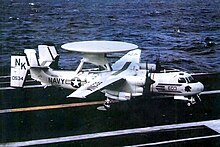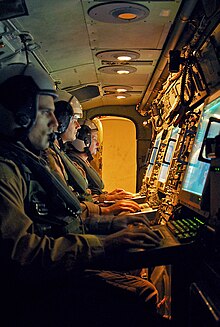Grumman E-2
| Grumman E-2 Hawkeye | |
|---|---|
 Grumman E-2C "Hawkeye" of the "Carrier Air Wing Five" |
|
| Type: | Early warning aircraft |
| Design country: | |
| Manufacturer: | |
| First flight: |
October 21, 1960 |
| Commissioning: |
January 1964 |
| Production time: |
1969 to 2009 |
| Number of pieces: |
205 |

The Grumman E-2 Hawkeye is an all-weather, carrier-based early warning aircraft .
history
The constant improvements to the early airborne radars culminated in the mid-1950s with the concept of controlling the airspace with specially equipped aircraft that acted as early warning systems and coordinated defense efforts. The first aircraft in this role was the Grumman E-1B Tracer (a variant of the S-2 Tracker anti -submarine aircraft ), which was in service from 1958 to 1977. The successor to the E-1B, the E-2 Hawkeye, was not only the first carrier-based aircraft in this role, but also the first machine specially designed for this purpose. The first flight of the prototype called W2F-1 took place on October 21, 1960 after the corresponding tender was won in March 1957. Since it replaced the E-1 in 1964, the E-2 has been the "eye of the fleet". She had her baptism of fire at the end of 1965 in the Vietnam War ; since then she has served the Navy in all conflict areas around the world where the US aircraft carriers were in service. Hawkeyes led the F-14 Tomcat fighters that flew combat missions during the 1986 Libya crisis, working with Navy cruisers equipped with the Aegis combat system to ensure air superiority. The E-2B, modernized in avionics and weapon computers, had its maiden flight on February 20, 1969 and was used from 1970. The E-2C had its maiden flight on January 20, 1971. More recently, they provided command and control over Navy operations in the Persian Gulf , leading both ground troops and air patrols, and assisting in the shooting down of two Iraqi MiG-21s by F / A-18 Hornets in the first days of the war . E-2s also worked very effectively in law enforcement actions as part of the US government's anti-drug campaigns.
In addition to the US Navy , the French Navy, Republic of China (Taiwan) , Israel and the armed forces of Egypt also fly the Hawkeye.
The E-2D Advanced Hawkeye is currently in development; it will probably be the last aircraft based on the E-2 Hawkeye. The E-2D is based on the Hawkeye 2000 and for the first time has a new rotatable radar with electronic beam panning (APY-9 in the UHF range from 10 to 100 centimeters wavelength). Furthermore, an improved communication system (Link-11 and two Link-16) and new mission systems with an open system architecture (e.g. 21-inch screens) were installed. If necessary, the copilot can now be deployed as the fourth tactical operator in the new glass cockpit . Another goal was to reduce production and maintenance costs. The first flight of the E-2D Delta One took place on August 3, 2007. The first machines were delivered in 2011. The US Navy has currently announced a need for 75 aircraft.
construction
The Hawkeye provides airborne early warning, command and control capabilities for the carrier combat group . Other possible missions include coordinating ground troop movements, commanding fighter jets , interceptors and SAR units, and the role of a communications relay. The latest version E-2C (in service since 1973) uses computer-aided sensors to provide early warning, threat analysis and control of countermeasures against both ground and air threats. Constructively, the E-2 is a high- wing aircraft with a rotating radar dome 7.32 m in diameter (24 feet) on the back of the fuselage, in which stacked antenna elements are housed. Two Allison propeller engines with four-bladed propellers from Hamilton are attached to the trapezoidal wings. These are provided with a special plastic coating to suppress radar interference. The complicated flow conditions around the dome make a multi-part tail fin necessary. The Hawkeye's on-board equipment includes digital data links such as Link 11 and Link 4, and more recently Link 16 , with which the air situation is passed on to the unit in real time by the three system officers on board. The air inlet for the cooler of the air-conditioned cabin and the electronics, which is clearly visible on the fuselage under the right wing, is striking.
variants
- E-2A (until 1962 XW2F-1)
- First production version with AN / APS-96 radar, 59 built
- TE-2A
- Trainer version (2 pieces converted from E-2A)
- E-2B
- modernized (rebuilt) version of the E-2A, 50 converted
- E-2C
- Main production version with APS-120 or from 1976 with APS-125 radar (later retrofitted with eight-blade propellers NP-2000 from Hamilton), recognizable by the extended nose and the larger radiator
- E-2C "Group 0"
- modernized E-2C with APS-138 radar, in service from 1980
- E-2C "Group 1"
- modernized E-2C with APS-139 radar (four times the trackable number of targets) and more powerful engines, from the late 1980s
- E-2C "Group 2"
- modernized E-2C with APS-145 radar (increased range and better detection of small objects and objects on the ground, can detect more than 20,000 objects simultaneously), in service from 1992
- E-2C Hawkeye 2000
- modernized E-2C with a more powerful central computer from Raytheon and CEC integration. The first flight took place in April 1998, production has been running since 2001, with all 21 newly built machines ordered by the US Navy being delivered by September 2009. Japan will upgrade 9 of its 13 E-2Cs to the 2000s. Taiwan received two newly built machines by 2004.
- TE-2C
- Trainer version
- E-2D
- Comprehensively modernized E-2C-2000 version. Thanks to the AESA antenna, the new AN / APY-9 radar has significantly better performance parameters and greater reliability than the APS-145. The location range has been almost doubled compared to the APS-145. The high-performance transmitters use silicon carbide as the semiconductor material and the friend-foe identification is handled by an ADS-18 / RCA. The radar continues to work in the UHF range, can still be rotated and thus allows both a 360 ° scan every twelve seconds and the electronic beam pivoting by 90 ° to keep certain targets in view for longer. The rest of the avionics were also extensively modernized. The E-2D now has a new glass cockpit with three 43 cm screens. The glass cockpit now makes it possible for the pilot or copilot to work as the fourth system officer. The three workplaces for the radar observer are equipped with 51 cm screens. Satellite communications are handled by an AN / ARC-210 and an HF-121C. The improved T56-A-427A engines have a modified reduction gear and increased emergency power for better rates of climb in the event of engine failure. In addition, the structure was reinforced to allow a higher landing mass on the carrier and reserves for future weight gain. Also new is the air conditioning system with greater cooling capacity, better air distribution, a pressurized radar cooling system and liquid cooling with polyalphaolefin . In addition, the aircraft also received new radio systems and the ability to refuel in the air . The first flight of the machine took place in August 2007. The first simulated carrier landings in October 2009 resulted in problems with the engine mounts, where excessive movement of the propeller turbines led to damage to a heat shield in the engine nacelle. The necessary modifications were made in July 2010 after the first machine was delivered to the US Navy. The first carrier landing took place on January 30, 2011. Operational readiness is to be achieved in 2014, with all E-2Cs to be replaced by the D variant over time (40 to 2018).
- E-2K
- E-2C Hawkeye 2000 for Taiwan
- E-2T
- Version for Taiwan (four pieces delivered in 1995, correspond to E-2C "Group 2"). All four will be upgraded to the E-2C Hawkeye 2000 standard.
User states

-
 Egypt
Egypt
- Egyptian Air Force
-
 France
France
- French Navy ( Aéronavale ) - The only user state besides the United States to use the Hawkeye on aircraft carriers.
-
 Israel
Israel
- Israeli Air Force - Former owner, all Hawkeyes were sold to Mexico.
-
 Japan
Japan
- Japan Air Self-Defense Force
-
 Mexico
Mexico
- Mexican Navy
-
 Singapore
Singapore
- Republic of Singapore Air Force
-
 Taiwan
Taiwan
- Air Force of the Republic of China
-
 United States
United States
- United States Navy
Technical specifications
| Parameter | Data |
|---|---|
| Main function | Airborne early warning, command and control |
| Manufacturer | Grumman Aerospace Corporation |
| length | 17.6 m |
| span | 24.56 m (8.94 m wings folded) |
| height | 5.58 m |
| Wing area | 65.03 m² |
| Tank capacity | 6,900 l |
| Empty weight | 18,090 kg (18,365 kg E-2D) |
| Maximum takeoff weight | 23,850 kg to 26,080 kg (E-2D) |
| Marching speed | 480 km / h (long distance) |
| Maximum cruising speed | 602 km / h |
| Top speed | 593 km / h (E-2A) to 626 km / h (E-2C, E-2D) |
| Climbing time to 9,390 m | 33.5 min |
| Service ceiling | 9,100 m (E-2A), 9,390 m (E-2C), 11,275 m (E-2D) |
| Transfer range | 3,065 km (E-2A) to 2,855 km (E-2C, E-2D) |
| Maximum duration of use | 6 h 15 min |
| Landing runway: | 440 m |
| Crew: | five (two pilots and three system officers in the air-conditioned cabin) |
| Armament | no |
| Drive: | two Allison T56 -A427- turboprop engines with 3,800 kW each (depending on the version also T56-A8 / 8, T56-A425, T56-A427A) |
APS-145 radar data
- Antenna weight: 772 kg
- Antenna dimensions (height × diameter): 0.76 × 7.32 m
- Frequency range : 400-450 MHz (16 selectable ranges)
- Impulse power : 1 MW
- Transmission time: 13 μs
- Antenna rotation time: 12 seconds
- Opening angle: 7 ° × 20 °
- Range:
- big goal: 650 km
- Cruise missiles : 270 km
- Actionable Targets: 2,000
See also
- Embraer R-99A (EMB-145SA with the same Eriye radar as Saab 340AEW)
- KongJing-2000 "Mairing" (Il-76 AWACS)
- KJ-200 (Shaanxi Y-8 AWACS)
- Boeing E-3A "Sentry" (AWACS)
- Boeing 737 AEW & C (Boeing 737-700ER AWACS)
- Berjew A-50A "Mainstay"
- Tupolev Tu-126 "Moss" (now out of service)
- Saab 2000 Erieye AEW & C
- Saab 340B AEW-300 (S-100D "Argus" with Erieye radar system)
Web links
Individual evidence
- ↑ a b FliegerRevue May 2010, pp. 24–27, Hawkeye sharpens his senses
- ↑ AEROSPACE AMERICA / NOVEMBER 2008 - Airborne early warning acquires new targets ( Memento from January 15, 2011 in the Internet Archive )
- ↑ FlugRevue July 2011, pp. 52–55, Inner values - Northrop Grumman E-2D before troop testing
- ↑ Forecast International ( page no longer available , search in web archives )




